Koshari is an Egyptian comfort food dish that is so flavorful and delicious it has been named the national dish of Egypt. Layered rice, lentils, pasta, chickpeas and sauces, all topped with crispy fried onions make this vegan Mediterranean dish irresistible!
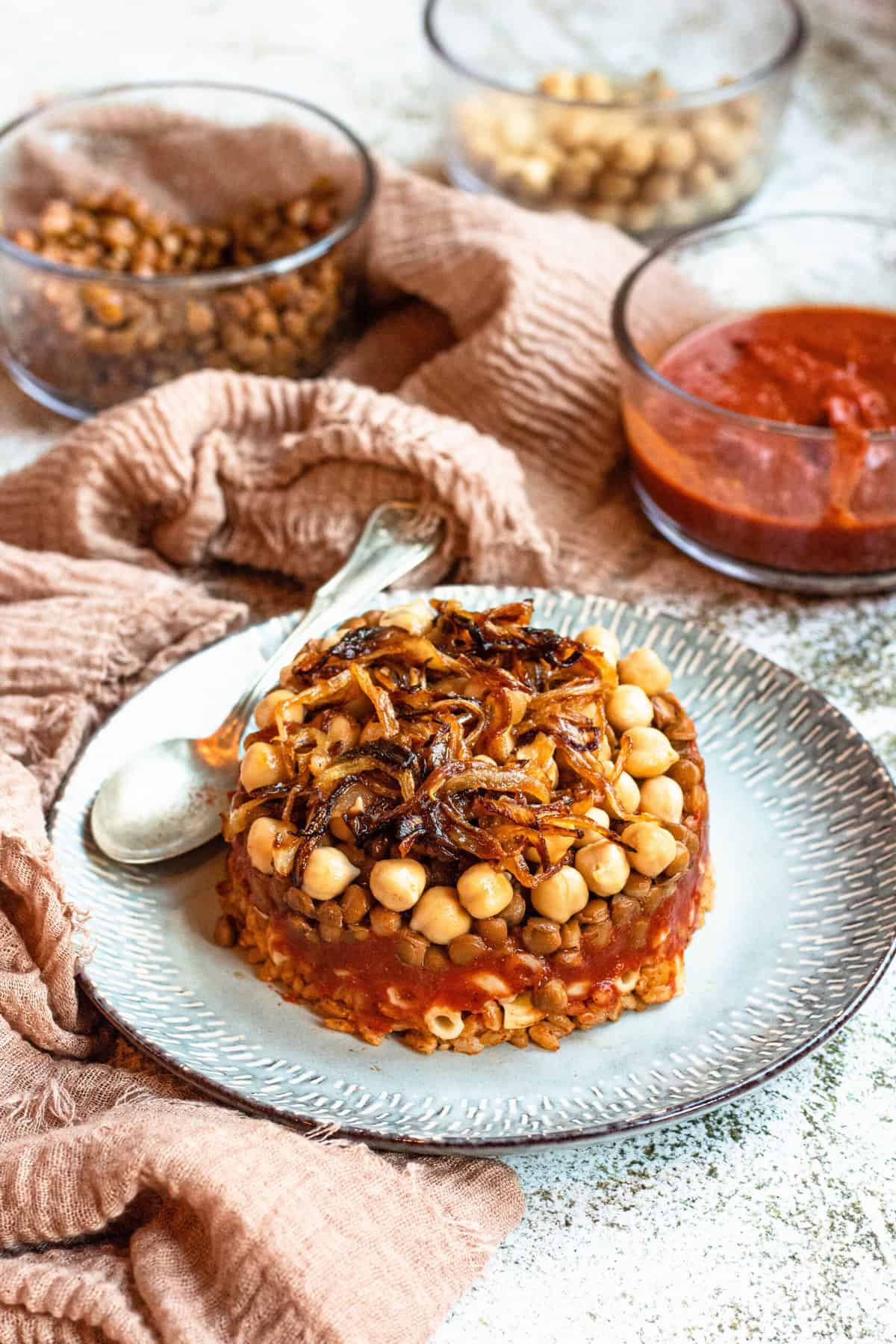
“Hello Reader! I try my hardest to research recipes as best as I can before posting to ensure I am representing each culture correctly. If this recipe is from your country and I have made a mistake or you have suggestions for how to make it more authentic, I would love to hear! Please leave a comment below letting me know what should be different, and I will rework the recipe. It is always my intention to pay homage and respect to each cultural dish that I cook. Thanks for reading!”
Koshari is an Egyptian dish full of culture and flavor. It’s a perfect combination of ingredients that have traveled to Egypt over the years, all brought together in one delicious, hearty, vegan meal.
It may also be a dish that at first glance doesn’t get the credit it deserves. It’s built using such simple pantry staples that it may be easy to underestimate it. The base is layers of rice, lentils, chickpeas and pasta.
However, it’s the sauces that really make this Egyptian street food amazing. Lots of spicy tomato sauce and the fried crispy onions on top make it perfection.
Like most dishes from around the world, the spelling may vary from one source to the next. It is sometimes called Koshari, kushari or koshary. Kushary means “blended” in Arabic, while “kosheri” means to mix things together in Greek. Both make sense for this perfectly layered dish.
While this Egyptian Koshari Recipe is made up of simple ingredients, it may take some time to put together as each ingredient is cooked up separately. It’s a great meal to make to use up leftover pasta, rice, lentils or chickpeas.
Even if you’re starting from scratch, each ingredient is simple to cook and the end result is worth it! You will end up with a lunch or dinner that is filling and makes you savor every bite.
Recipe Origins
Koshari is Egypt’s national dish, made up of flavorful lentils, rice, pasta and chickpeas bound together with a tomato sauce and cumin sauce and topped with fried onions. It’s a perfect melting pot of the various cultures that have passed through Egypt.
The origin of the dish actually comes from India. It’s based on a dish called Khichri/Khichdi. This variation of the dish is a rice and lentil dish associated with good fortune. It was brought to Egypt by the Indian soldiers who had joined British troops in the early 1900s after World War I.
Egyptians put their own twist on the dish, adding chickpeas, crispy thin fried onion rings and extra spices. The pasta may have been added by Italians who had made their way to Egypt
Koshari became widely available from street vendors who still sell the dish today, and eventually made its way into restaurants. Its name comes from the ancient Egyptian word “Koshir” from the Egyptian Book of Genesis, meaning “food of the rites of the gods”.
The simple ingredients make the dish inexpensive to make and all the carbohydrates and protein make it very filling too. This delicious vegetarian meal is easy to make at home with some pantry staples and a dash of spices. The combination of textures and flavors will leave you feeling full and satisfied.
This specific recipe was reviewed and edited by my friend Noha that lives in Egypt. Check her out on instagram at @mattersofthebelly.
Why Make This Recipe
- Use up Leftovers: If you have already cooked basmati rice, lentils, chickpeas or pasta, this is a great recipe to use them up in a unique way.
- Meatless Meal: This dish is an excellent vegetarian and vegan recipe with so much flavor you will not be missing out on the meat!
- Experience Egypt: Koshari is a must-try when visiting Egypt but if making the trip isn’t in your budget right now, you can still experience a piece of the culture through this dish.
What Do I Need To Make This Recipe
Ingredients
Here is a visual overview of the ingredients in the recipe. Scroll down to the recipe at the bottom for quantities.
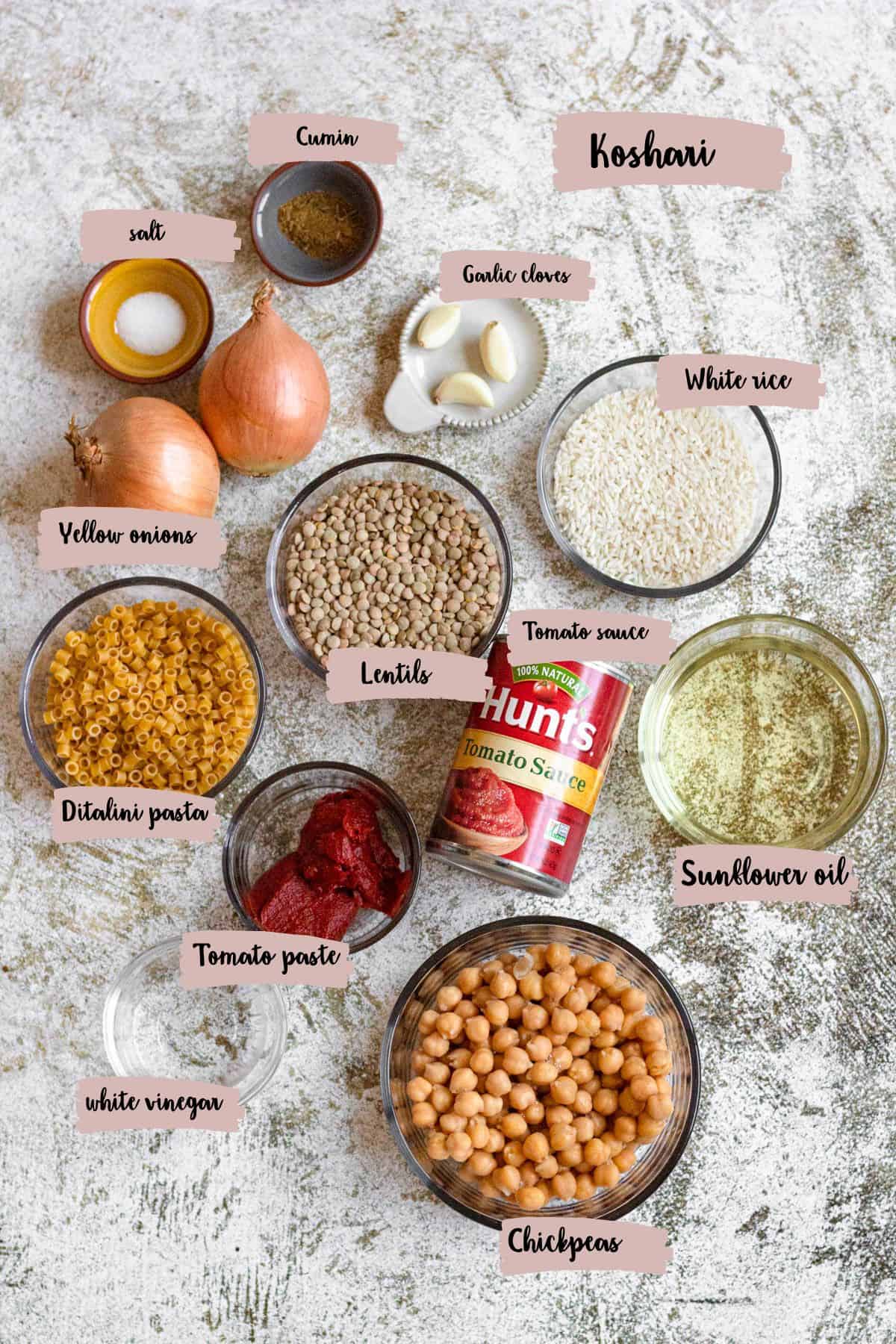
- Onions: Yellow onion works best, but you could also use a red onion or white onion. You’ll slice this thin and fry the slices in sunflower oil. Save the oil for cooking the rest of your ingredients.
- Rice: Traditionally Koshari is made with Basmati rice, but you could use jasmine rice or any medium grain white rice. If you want to make the recipe a little healthier you could also substitute brown rice.
- Lentils: Brown lentils are preferred but green lentils work just as well. In a true Egyptian kitchen, the lentils are cooked fresh. If you are really in a pinch, you can use canned lentils.
- Pasta: Ditalini pasta noodles are best but I’ve seen it made with elbows if you have them on hand.
- Chickpeas: Traditional chefs will encourage you to use dried chickpeas (or garbanzo beans) and cook them, but canned chickpeas work just as well and are less work to prepare.
- Tomato Sauce: You’re going to use tomato sauce, tomato paste and white vinegar to make the vinegary sauce that tops this dish. This vinegar tomato sauce is what the Egyptian national dish is best known for.
- Cumin Sauce: Use crushed garlic and ground cumin.
Tools
- Large Skillet: You’ll need a frying pan to fry up the onions. Save the oil from frying to use in the rest of the steps from this dish!
- Several Pots: This recipe doesn’t call for any special equipment but you will need several pots to cook the different ingredients. They don’t come fully together until the end.
How To Make This Recipe
Step 1: Fry Your Onions
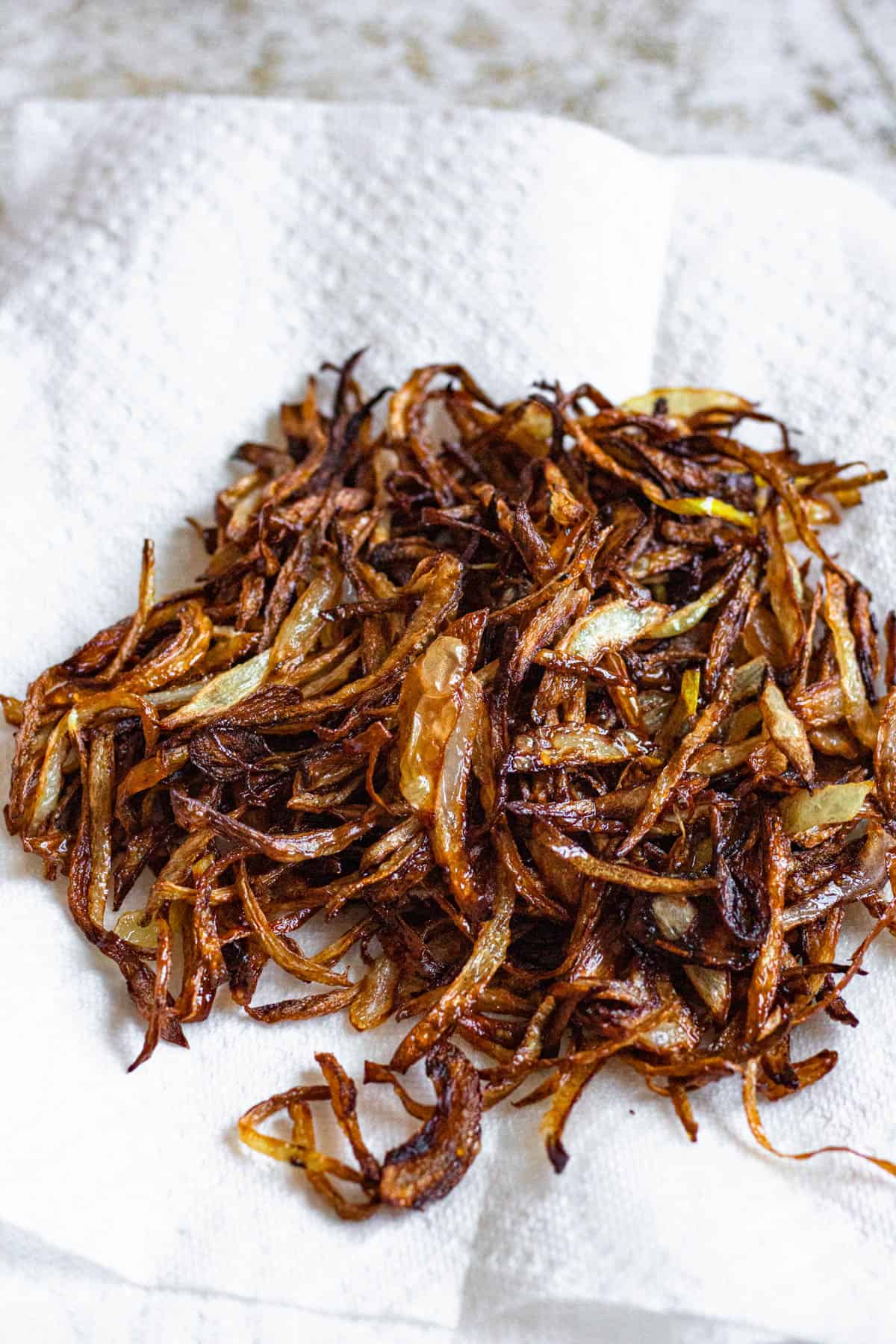
Add about ½ inch sunflower oil to the bottom of a medium-sized pot. When the oil reaches 350 degrees Fahrenheit, you can begin frying.
Slice a small onion into thin rings. Add the onions to the oil and fry the onions for about 7-10 minutes, until they get smaller and then begin to brown. Stir occasionally to make sure they cook evenly.
Remove the golden brown onion from the oil and place on a paper towel lined plate to drain off any excess oil.
Reserve the excess oil for the remainder of the steps.
Step 2: Prepare Your Layers
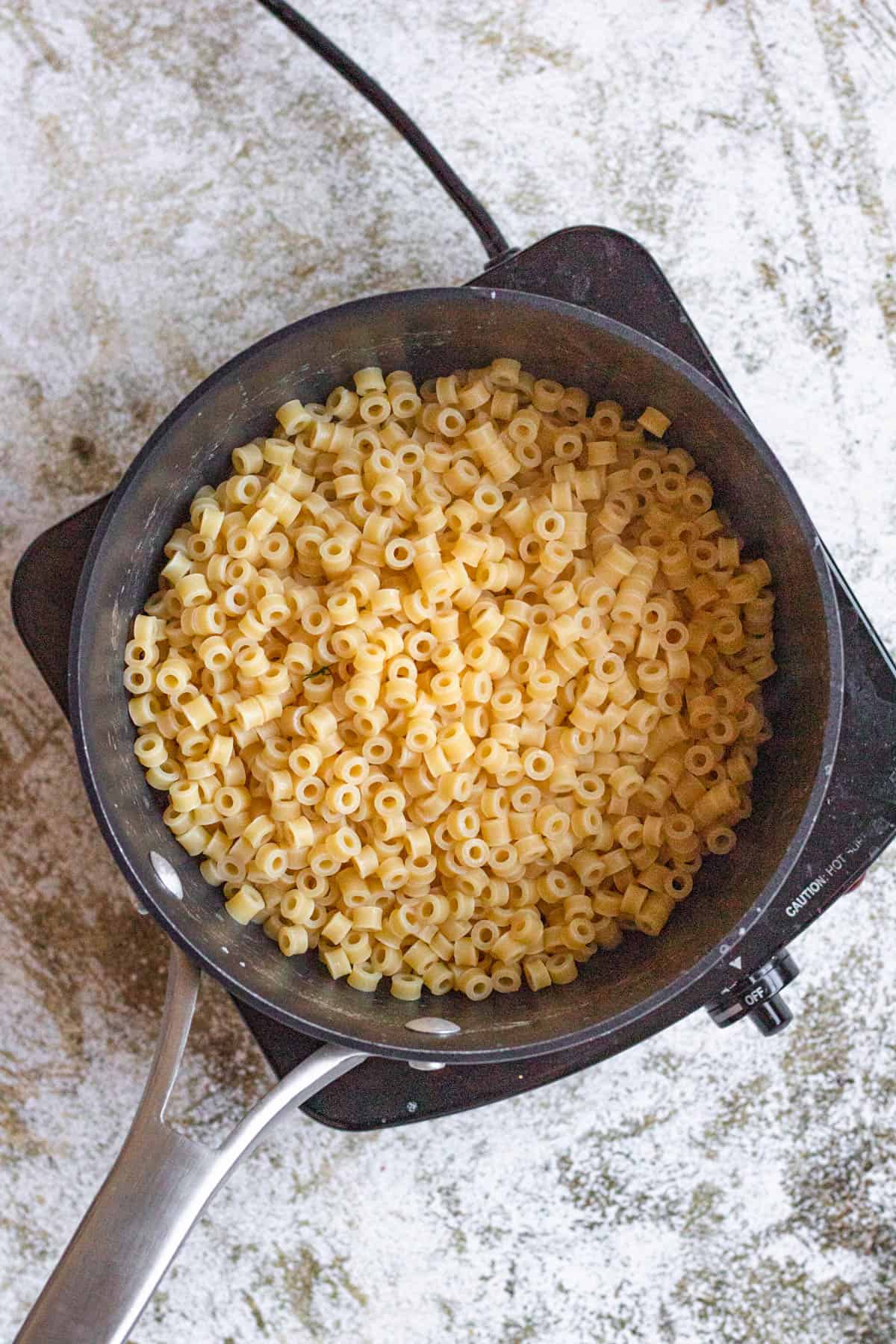
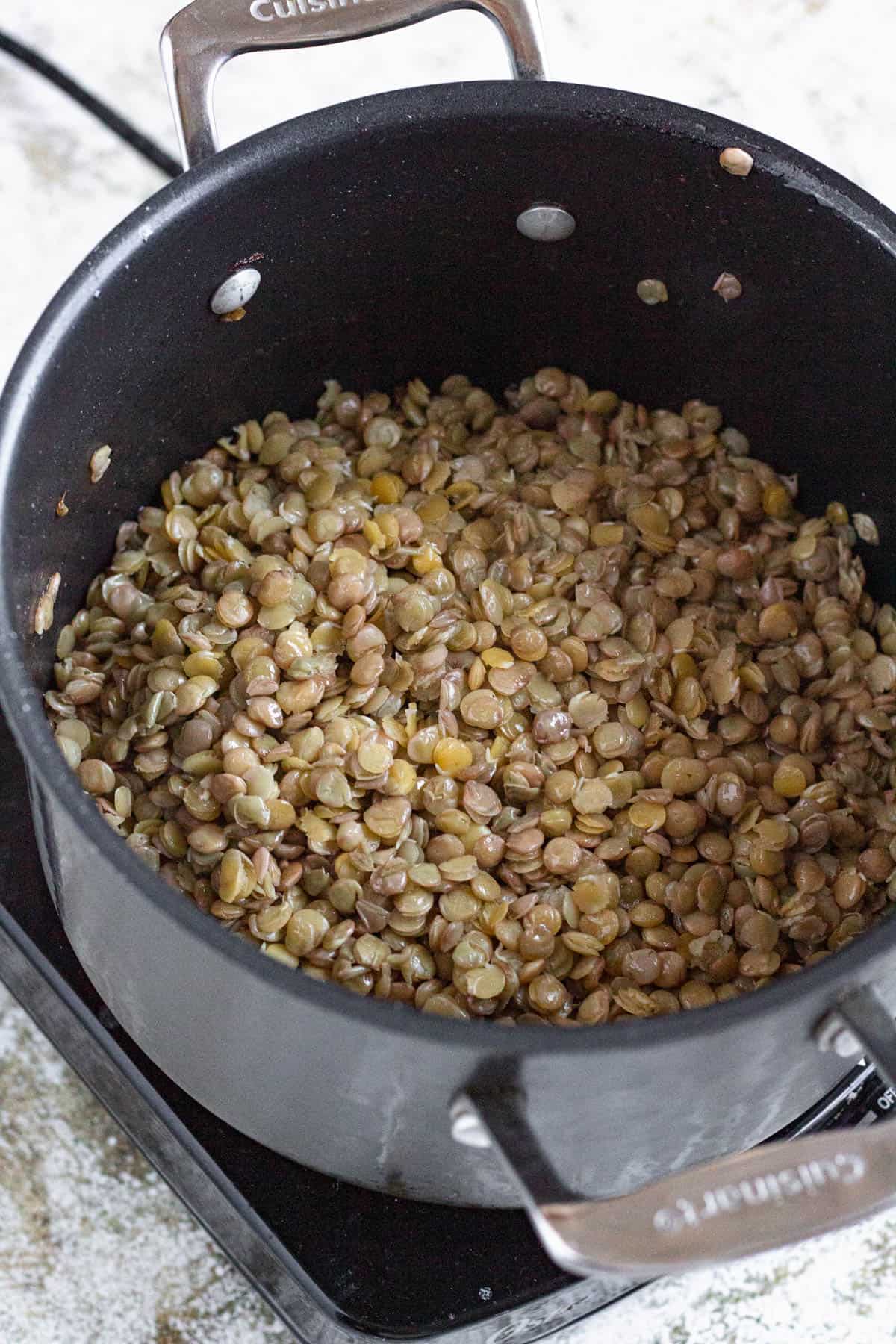
Cook the noodles and rice according to the package instructions till al dente. Once cooked, set aside.
In a medium pot over medium-high heat add the oil until warmed, then add the soaked and drained lentils. Stir over the heat for about 2 minutes.
Add four cups of water into the pot and bring it to a boil.
Cover, reduce the heat, and simmer on low heat for 15-20 minutes, stirring occasionally. Cook the lentils until they are tender but not mushy.
Drain any remaining water and set the lentils aside.
Step 3: Make Your Sauces
Cumin Sauce Instructions
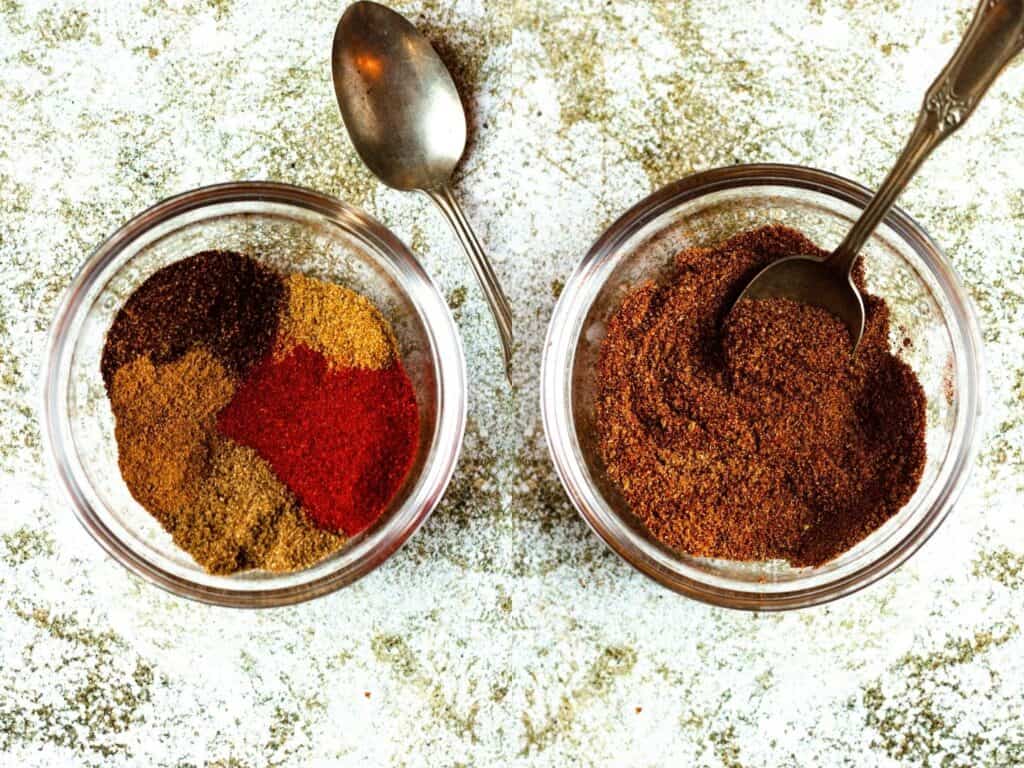
In a small bowl or jar, add all of the cumin sauce ingredients. Whisk together until combined, then set aside.
Allow to sit for 15 minutes.
Tomato Sauce Instructions
In a medium saucepan, add oil until warmed through. Then add the garlic and saute until fragrant.
Add the tomato sauce, tomato paste, water, vinegar, and salt.
Bring to a boil, then reduce the heat to a simmer and cover. Allow the sauce to simmer for 15 minutes. Then set aside.
Step 4: Assemble Your Dish
Assemble the Koshari by layering the rice and lentils on the bottom of a platter, then top with cooked pasta, chickpeas, and fried onion. Then drizzle the entire plate with the cumin sauce and tomato sauce.
Expert Tips
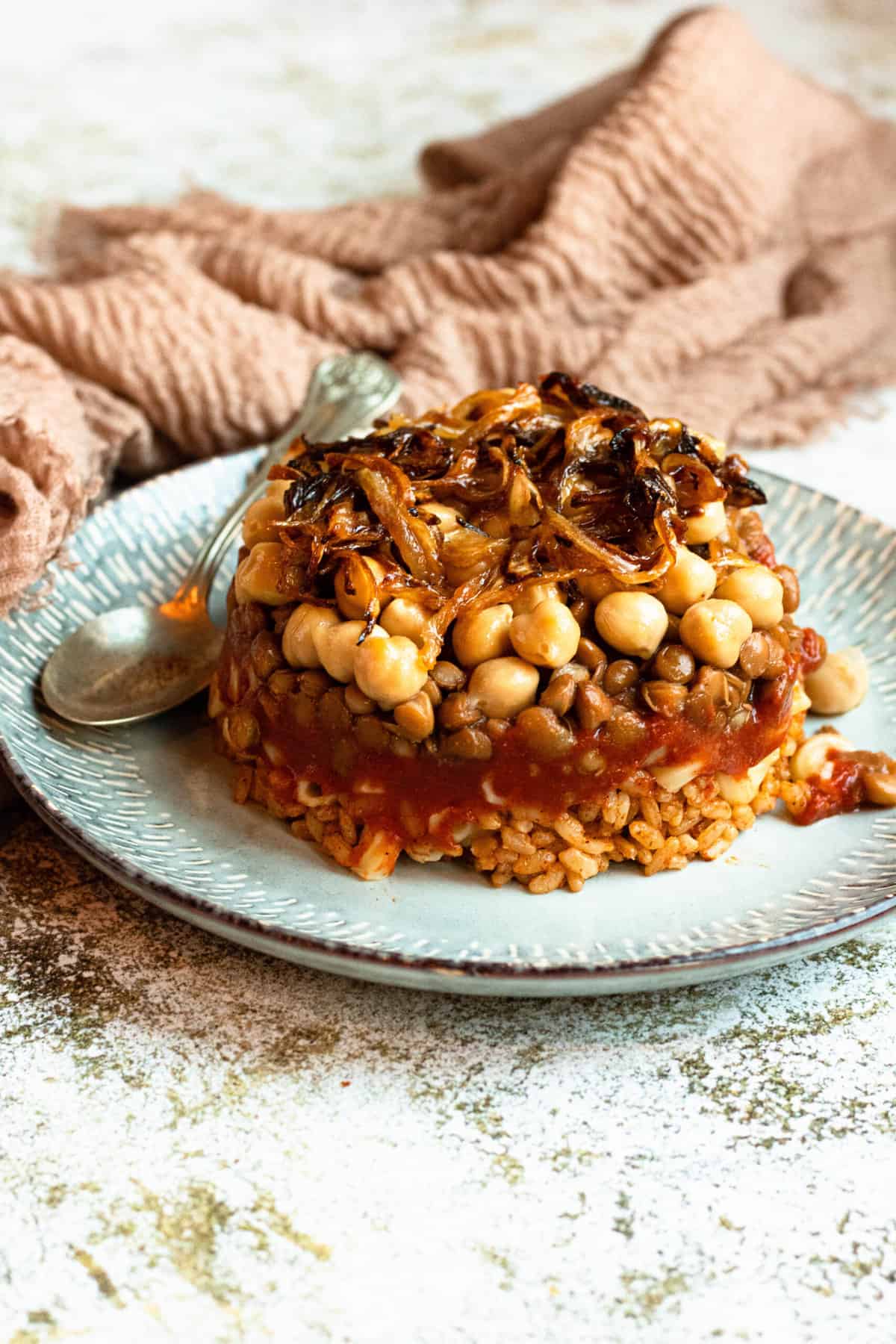
- Some people like to cook the rice in the same water from the lentils by adding rice to the pot when the lentils are halfway cooked. This gives the rice a nice brown tint and would save you from cleaning one more pot. If you prefer the look of clean layers or have some eaters who don’t like the lentils, stick to cooking them separately.
- The oil from the onions adds great flavor to the other ingredients. You can make your sauce, lentils and even the rice with some of that oil.
- If you like a little spice, try adding cayenne or red pepper flakes to your tomato sauce. You could also add hot sauce to the table for those who want to add their own spice.
- If you’d like to make this recipe a little healthier, you can use whole wheat pasta or brown rice instead of the white rice and pasta.
- This is a great make-ahead meal as each ingredient can be prepared and saved but I recommend making the onions fresh so they can retain the nice crisp.
- Some recipes call for using Baharat Seasoning in place of cumin. If you choose to go this route, make sure to use my Baharat spice blend recipe.
Stacking your Koshari
You can really blow your guests away by stacking the ingredients into a tower. To do so, use a small bowl. In the bowl, layer the ingredients in the following order:
- Fried onions
- Chickpeas
- Pasta
- Cooked rice
- Lentils
Flip the bowl over onto a plate, allowing the Koshari to release itself from the sides. Lift away the bowl and drizzle with the tangy tomato sauce and cumin sauce. Enjoy!
FAQs
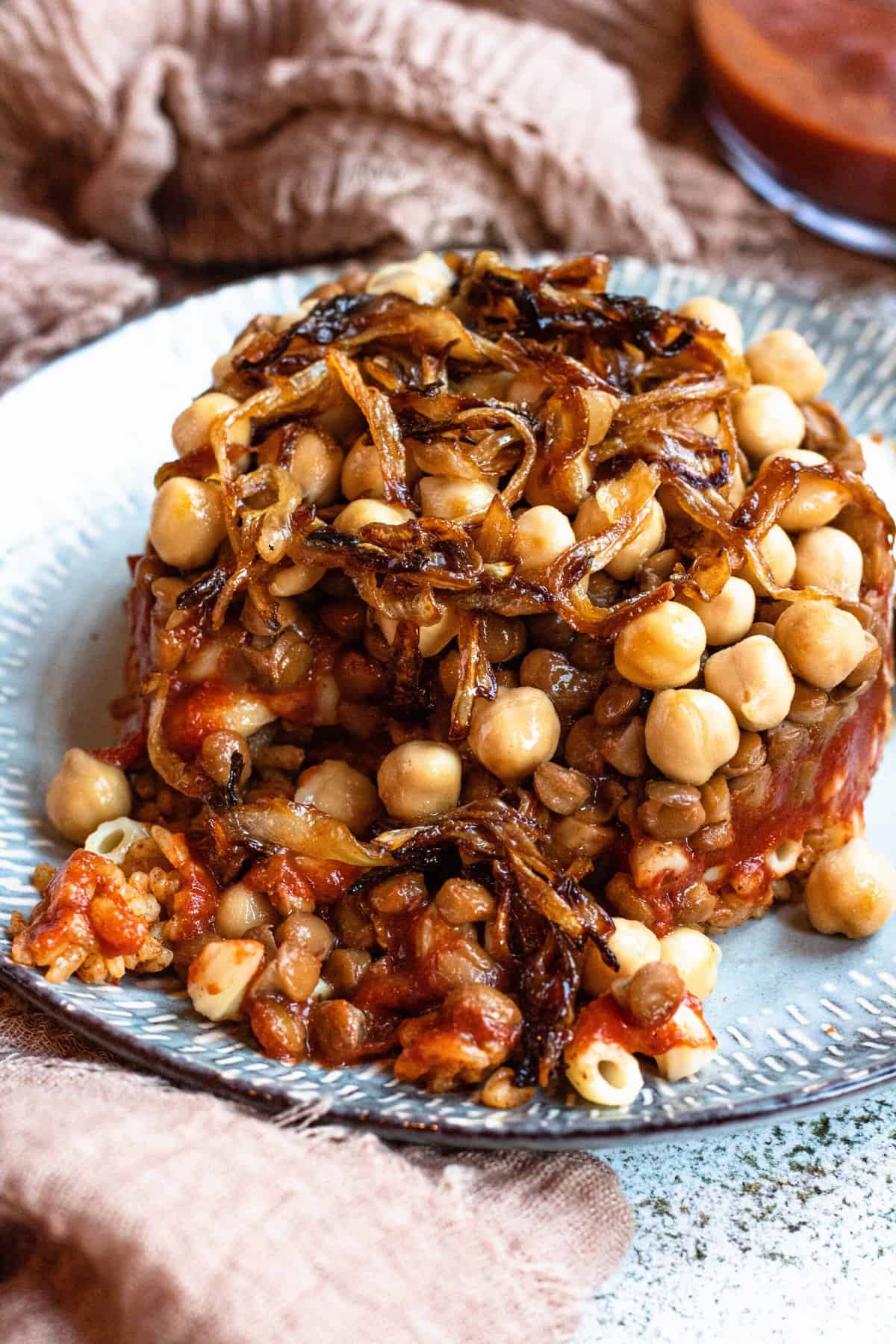
and plant-based protein from the lentils and chickpeas. The lentils are a great source of fiber. The tomato sauce is full of vitamin C. It’s a great meatless meal and good fuel for helping you get moving.
Koshary tastes like a big bowl of savory goodness. Rice and beans are always a winning combination and when you top them with these amazingly flavorful tomato and cumin sauces, it’s a must-try.
When Koshari is cooked in Egyptian homes, it is usually served by itself. Many hosts serve the ingredients separately so each person can add or leave out anything they do or do not want. If you do want to add some sides you could serve a simple Mediterranean salad or some boiled eggs.
Each ingredient of Koshari is easy to make, but because each is cooked individually the prep time may take a while.
Prep time also depends on whether or not you are using canned chickpeas or boiling them yourself. For your first time making koshary I would anticipate it taking a couple hours but as you become familiar with the recipe, this timing goes down.
If you want to make koshari ahead of time, feel free to do so! To store your koshari properly, store each of the ingredients individually.
Then, when it is time to make your koshari, heat up the ingredients and assemble in the bowl at this point. This will allow you to keep the beautiful shape of the koshari without being worried about too much movement in the microwave causing it to topple. It’s also a good idea to make the onions fresh every time for the best crispy texture.
No. If you want to create a less high-maintenance version of this dish, you can do so by simply placing the ingredients on a plate.
Though the layering in the bowl creates a fun effect, it is not a requirement.
Some people like to lay the ingredients out next to each other on a large serving platter so guests can fill their own dishes with just the portion they like most.
Did you like this recipe for Koshari/Koshary? If so, make sure to check out these other recipes I picked out just for you:
- Butter Cookies from Egypt
- Muhammar Sweet Rice from Bahrain
- Machboos from Bahrain
- 20 Rice Recipes to Make with the Rice in your Pantry
- Coconut Milk Rice with Red Beans

Koshari
Ingredients
Dry Ingredients
- 8 oz Ditalini , dry; or elbow noodles
- 1 ½ cups Medium grain white rice, dry
- 2 15 oz Chickpeas, drained and rinsed
Fried Onion Ingredients
- 2 Yellow onions, sliced thinly
- Sunflower oil for frying
Lentil Ingredients
- 2 tbsp Sunflower oil, reserved from frying the onions
- 1 ¼ cup Dried brown lentils, rinsed
- 4 cups Water
Tomato Sauce Ingredients
- 2 tbsp Sunflower oil, reserved from frying the onions
- 2 cloves Garlic, minced
- 1 15 oz Tomato sauce
- 1 6 oz Tomato paste
- 2 cups Water
- ¼ cup White vinegar
- Salt, to taste
Cumin Sauce Ingredients
- 1 tbsp Sunflower oil, reserved from frying the onions
- 1 tsp Crushed garlic
- ½ tbsp Ground cumin
- ⅓ cup Boiling Water
- 3 tbsp White vinegar
- ½ tsp Salt
Instructions
- Dry Ingredient Instructions
- Cook 8 oz noodles according to the package instructions. Once cooked, set aside.
- Cook 1 ½ cups rice according to the package instructions. One cooked, set aside.
- Onion Instructions
- Add about ½ inch sunflower oil to the bottom of a medium-sized pot. When the oil reaches 350 degrees Fahrenheit, you can begin frying.
- Add 2 onions thinly sliced to the oil and fry the onions for about 7-10 minutes, until they get smaller and then begin to brown. Stir occasionally to make sure they cook evenly.
- Once the onions have browned, remove them to a paper towel lined plate to drain off any excess oil.
- Reserve the excess oil for the remainder of the steps.
- Lentil Instructions
- In a medium pot over medium heat add the 2 tbsp oil until warmed, then add the soaked and drained 1 ¼ cups lentils. Stir over the heat for about 2 minutes.
- Add 4 cups water into the pot and bring it to a boil.
- Cover, reduce the heat, and simmer for 17-20 minutes, stirring occasionally. Cook the lentils until they are tender but not mushy.
- Drain any remaining water and set the lentils aside.
- Cumin Sauce Instructions
- In a small bowl or jar, add all of the cumin sauce ingredients. Whisk together until combined, then set aside.
- Allow to sit for 15 minutes.
- Tomato Sauce Instructions
- In a medium saucepan, add 2 tbsp oil until warmed through. Then add the 1 tsp garlic and saute until fragrant.
- Add the 15 oz tomato sauce, 6 oz tomato paste, 2 cups water,¼ cup vinegar, and salt to taste.
- Bring to a boil, then reduce the heat to a simmer and cover. Allow the sauce to simmer for 15 minutes. Then set aside.
- Assemble
- Assemble the koshari by layering the rice and lentils on the bottom, then top with cooked pasta, chickpeas, and fried onion. Then drizzle the entire plate with the cumin sauce and tomato sauce
- You can really blow your guests away by stacking the ingredients into a tower. To do so, use a small bowl. In the bowl, layer the fried onions, chickpeas, pasta, then rice and lentils, in that order. Flip the bowl over onto a plate, allowing the koshari to release itself from the sides. Lift away the bowl and drizzle with the tomato sauce and cumin sauce. Enjoy!
Notes
- Onions: Yellow onion works best, but you could also use a red onion or white onion. You’ll slice this thin and fry the slices in sunflower oil. Save the oil for cooking the rest of your ingredients.
- Rice: Traditionally Koshari is made with Basmati rice, but you could use jasmine rice or any medium grain white rice. If you want to make the recipe a little healthier you could also substitute brown rice.
- Lentils: Brown lentils are preferred but green lentils work just as well. In a true Egyptian kitchen, the lentils are cooked fresh. If you are really in a pinch, you can use canned lentils.
- Pasta: Ditalini pasta noodles are best but I’ve seen it made with elbows if you have them on hand.
- Chickpeas: Traditional chefs will encourage you to use dried chickpeas (or garbanzo beans) and cook them, but canned chickpeas work just as well and are less work to prepare.
- Tomato Sauce: You’re going to use tomato sauce, tomato paste and white vinegar to make the vinegary sauce that tops this dish. This vinegar tomato sauce is what the Egyptian national dish is best known for.
- Cumin Sauce: Use crushed garlic and ground cumin.
- Some people like to cook the rice in the same water from the lentils by adding rice to the pot when the lentils are halfway cooked. This gives the rice a nice brown tint and would save you from cleaning one more pot. If you prefer the look of clean layers or have some eaters who don’t like the lentils, stick to cooking them separately.
- The oil from the onions adds great flavor to the other ingredients. You can make your sauce, lentils and even the rice with some of that oil.
- If you like a little spice, try adding cayenne or red pepper flakes to your tomato sauce. You could also add hot sauce to the table for those who want to add their own spice.
- If you’d like to make this recipe a little healthier, you can use whole wheat pasta or brown rice instead of the white rice and pasta.
- This is a great make-ahead meal as each ingredient can be prepared and saved but I recommend making the onions fresh so they can retain the nice crisp.
- Some recipes call for using Baharat Seasoning in place of cumin. If you choose to go this route, make sure to use my Baharat spice blend recipe.







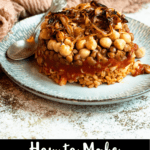

Adam says
Hi ! This recipe sounds delicious & looks amazing . Im half Egyptian and Koshari is one of my favorite foods. Even with the most traditional dishes, every cook can add their personal touch, in this case the cinnamon, nutmeg & paprika. I never noticed these in the sauce, but They wont hurt the recipe . In fact I think theyll add some depth. The only tip I’ll give you regarding authentic egyptian flavors is that Garlic, Cumin and Coriander are the foremost flavors. That combination is the key. Also, they love to add a touch of white vinegar. Try frying minced Garlic first , add the Spices then deglaze with vinegar before adding the tomatoes.
The Foreign Fork says
Thank you for your kind and helpful comment Adam!! There is a note in this recipe that it is not made entirely traditionally, and I thank you for the extra detail you added!